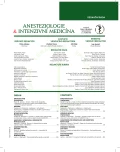Inhalational application of furosemide – the breathlessness panacea?
Authors:
R. Škulec
Authors‘ workplace:
Klinika anesteziologie, perioperační a intenzivní medicíny, Univerzita J. E. Purkyně v Ústí nad Labem
Masarykova nemocnice v Ústí nad Labem
1; Zdravotnická záchranná služba Středočeského kraje, Kladno
2; Klinika anesteziologie a intenzivní medicíny, Univerzita Karlova, Lékařská fakulta v Hradci Králové, Fakultní
nemocnice Hradec Králové
3; Centrum pro výzkum a vývoj, Univerzita Karlova, Lékařská fakulta v Hradci Králové, Fakultní nemocnice
Hradec Králové
4
Published in:
Anest. intenziv. Med., 28, 2017, č. 2, s. 101-105
Category:
Overview
Dyspnoea is a serious symptom requiring causal and/or palliative management in a variety of acute and chronic clinical conditions. It has been shown that inhaled furosemide (IAF) has the potential to be a new effective approach to dyspnoea management in a number of indications. This route of administration exerts significant bronchodilatation, relieves dyspnoea by suppressing the afferentation to the central nervous system and has a minimum diuretic effect. The author summarizes our current knowledge about the use of IAF in bronchial asthma, chronic obstructive pulmonary disease, heart failure and in the palliative treatment of dyspnoea, and presents a case report series in this article.
Keywords:
inhaled furosemide – dyspnoea
Sources
1. Greger, R., Wangemann, P. Loop diuretics. Ren. Physiol., 1987, 10, 3–4, p. 174–183.
2. Nishino, T., Ide, T., Sudo, T., Sato, J. Inhaled furosemide greatly alleviates the sensation of experimentally induced dyspnea. Am. J. Respir. Crit. Care Med., 2000, 161, 6, p. 1963–1967.
3. Nishino, T. Dyspnoea: Underlying mechanisms and treatment. Br. J. Anaesth., 2011, 106, 4, p. 463–474.
4. Jensen, D., Amjadi, K., Harris-McAllister, V., Webb, K. A., O’Donnell, D. E. Mechanisms of dyspnoea relief and improved exercise endurance after furosemide inhalation in COPD. Thorax, 2008, 63, 7, p. 606–613.
5. Nishino, T. Pathophysiology of dyspnea evaluated by breath-holding test: studies of furosemide treatment. Respir. Physiol. Neurobiol., 2009, 167, 1, p. 20–25.
6. Sudo, T., Hayashi, F., Nishino, T. Responses of tracheobronchial receptors to inhaled furosemide in anesthetized rats. Am. J. Respir. Crit. Care Med., 2000, 162, 3, p. 971–975.
7. Undem, B. J. The Role of Vagal Afferent Nerves in Chronic Obstructive Pulmonary Disease. Proc. Am. Thorac. Soc., 2005, 2, 4, p. 355–360.
8. Sant’Ambrogio, G., Widdicombe, J. Reflexes from airway rapidly adapting receptors. Respir. Physiol., 2001, 125, 1–2, p. 33–45.
9. Lee, L. Y., Pisarri, T. E. Afferent properties and reflex functions of bronchopulmonary C-fibers. Respir. Physiol., 2001, 125, 1–2, p. 47–65.
10. Niven, A. S., Argyros, G. Alternate treatments in asthma. Chest, 2003, 123, 4, p. 1254–1265.
11. Corboz, M. R., Ballard, S. T., Gao, H. et al. Differential effects of furosemide on porcine bronchial arterial and airway smooth muscle. J. Appl. Physiol., 2000, 89, 4, p. 1360–1364.
12. Saitoh, Y., Sasaki, F., Sakai, T. et al. Effects of inhaled furosemide after indomethacin premedication on bronchial hyperresponsiveness in patients with chronic congestive heart failure. Nihon. Kyobu. Shikkan. Gakkai. Zasshi., 1994, 32, 5, p. 413–417.
13. Bhure, U. N., Bhure, S. U., Bhatt, B. M. et al. Lung epithelial permeability and inhaled furosemide: added dimensions in asthmatics. Ann. Nucl. Med., 2009, 23, 6, p. 549–557.
14. Newton, P. J., Davidson, P. M., Krum, H., Ollerton, R., Macdonald, P. The acute haemodynamic effect of nebulised frusemide in stable, advanced heart failure. Heart. Lung. Circ., 2012, 21, 5, p. 260–266.
15. Cavaliere, F., Masieri, S. Furosemide protective effect against airway obstruction. Curr. Drug. Targets., 2002, 3, 3, p. 197–201.
16. Bianco, S., Pieroni, M. G., Refini, R. M., Rottoli, L., Sestini, P. Protective effect of inhaled furosemide on allergen-induced early and late asthmatic reactions. N. Engl. J. Med., 1989, 321, 16, p. 1069–1073.
17. Munyard, P., Chung, K. F., Bush, A. Inhaled frusemide and exercise-induced bronchoconstriction in children with asthma. Thorax, 1995, 50, 6, p. 677–679.
18. Seidenberg, J., Dehning, J., von der Hardt, H. Inhaled frusemide against cold air induced bronchoconstriction in asthmatic children. Arch. Dis. Child., 1992, 67, 2, p. 214–217.
19. Inokuchi, R., Aoki, A., Aoki, Y., Yahagi, N. Effectiveness of inhaled furosemide for acute asthma exacerbation: a meta-analysis. Crit. Care, 2014, 18, 6, p. 1–6.
20. Hinckley, J. Inhaled furosemide in the treatment of acute exacerbations of asthma. Acad. Emerg. Med., 2000, 7, 10, p. 1167.
21. Uronis, H. E., Currow, D. C., Abernethy, A. P. Palliative management of refractory dyspnea in COPD. Int. J. Chron. Obstruct. Pulmon. Dis., 2006, 1, 3, p. 289–304.
22. Kallet, R. H. The role of inhaled opioids and furosemide for the treatment of dyspnea. Respir. Care, 2007, 52, 7, p. 900–910.
23. Ong, K. C., Kor, A. C., Chong, W. F., Earnest, A., Wang, Y. T. Effects of inhaled furosemide on exertional dyspnea in chronic obstructive pulmonary disease. Am. J. Respir. Crit. Care Med., 2004, 169, 9, p. 1028–1033.
24. Sheikh Motahar Vahedi, H., Mahshidfar, B., Rabiee, H. et al. The adjunctive effect of nebulized furosemide in COPD exacerbation: a randomized controlled clinical trial. Respir. Care, 2013, 58, 11, p. 1873–1877.
25. Shimoyama, N., Shimoyama, M. Nebulized furosemide as a novel treatment for dyspnea in terminal cancer patients. J. Pain. Symptom. Manage., 2002, 23, 1, p. 73–76.
26. Kohara, H., Ueoka, H., Aoe, K. et al. Effect of nebulized furosemide in terminally ill cancer patients with dyspnea. J. Pain. Symptom. Manage, 2003, 26, 4, p. 962–967.
27. Wilcock, A., Walton, A., Manderson, C. et al. Randomised, placebo controlled trial of nebulised furosemide for breathlessness in patients with cancer. Thorax, 2008, 63, 10, p. 872–875.
Labels
Anaesthesiology, Resuscitation and Inten Intensive Care MedicineArticle was published in
Anaesthesiology and Intensive Care Medicine

2017 Issue 2
Most read in this issue
- Deep vein thrombosis and pulmonary embolism in pregnancy
- Dexmedetomidine and its use in anaesthesia and intensive care
- Inhalational application of furosemide – the breathlessness panacea?
- The physician and the law II – forensic medical experts and expert institutions
